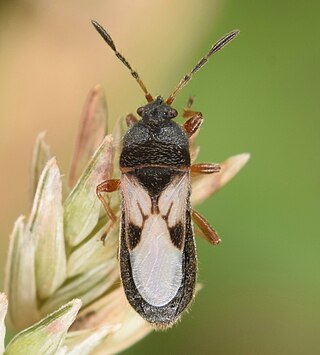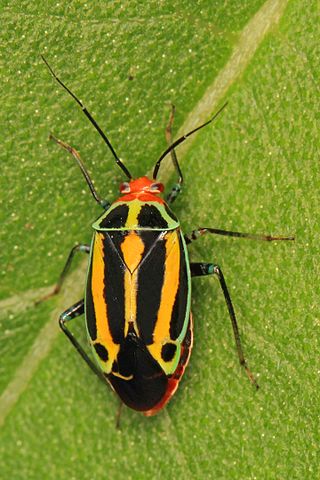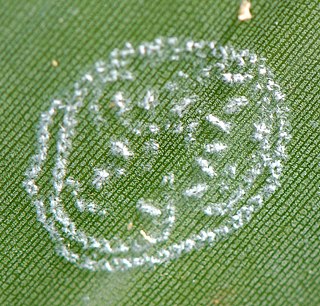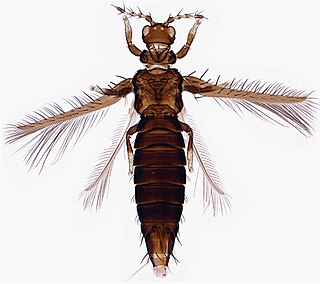Related Research Articles

Galls or cecidia are a kind of swelling growth on the external tissues of plants, fungi, or animals. Plant galls are abnormal outgrowths of plant tissues, similar to benign tumors or warts in animals. They can be caused by various parasites, from viruses, fungi and bacteria, to other plants, insects and mites. Plant galls are often highly organized structures so that the cause of the gall can often be determined without the actual agent being identified. This applies particularly to some insect and mite plant galls. The study of plant galls is known as cecidology.

Blissus leucopterus, also known as the true chinch bug, is a small North American insect in the order Hemiptera and family Blissidae. It is the most commonly encountered species of the genus Blissus, which are all known as chinch bugs. A closely related species is B. insularis, the southern chinch bug.

Phyllophaga is a very large genus of New World scarab beetles in the subfamily Melolonthinae. Common names for this genus and many other related genera in the subfamily Melolonthinae are May beetles, June bugs, and July beetles. They range in size from 12 to 35 mm and are blackish or reddish-brown in colour, without prominent markings, and often rather hairy ventrally. These beetles are nocturnal, coming to lights in great numbers.

The birch shield bug is species of shield bug in the Acanthosomatidae family. Shield bugs are often called "stink bugs" because they excrete a foul smelling liquid that is used to deter predators.

The Tingidae are a family of very small insects in the order Hemiptera that are commonly referred to as lace bugs. This group is distributed worldwide with about 2,000 described species.

Corythucha ciliata, the sycamore lace bug, is a species of lace bug in the family Tingidae that is associated with sycamore trees.

Gargaphia solani is a subsocial species of lace bug commonly known as the eggplant lace bug. The species was described by Heidemann in 1914 after it aroused attention a year earlier in the United States as an eggplant pest around Norfolk, Virginia. Fink found that the species became an agricultural pest when eggplant is planted on a large scale.

Sevenia boisduvali, the Boisduval's tree nymph, is a butterfly in the family Nymphalidae. There are four subspecies; all native to Africa.

Tessaratomidae is a family of true bugs. It contains about 240 species of large bugs divided into 3 subfamilies and 56 genera.

Poecilocapsus lineatus, commonly known as the Fourlined Plant Bug, is a species of true bug (Hemiptera) in the family Miridae. This species is native to the United States and Canada.

Aleurodicus dispersus, the spiralling whitefly, is a species of small, white sap-sucking insect, a true bug in the order Hemiptera. It originated in Central America and the Caribbean region and has spread to many of the world's tropical and subtropical regions, where it has become a major pest of agricultural crops.

Eriosoma lanigerum, the woolly apple aphid, woolly aphid or American blight, is an aphid in the superfamily Aphidoidea in the order Hemiptera. It is a true bug and sucks sap from plants.

Anthocoris nemoralis is a true bug in the family Anthocoridae. The species is native to Europe and is introduced in North America. It is a predator of aphids, spider mites and jumping plant lice, and is therefore used as a biological pest control agent.
Tomostethus multicinctus, common name brownheaded ash sawfly, is a species of sawfly in the family Tenthredinidae that is native to southern Canada and the eastern United States. Adults of this species resemble wasps and the larvae feed on the leaves of ash trees.

Corythucha gossypii, the cotton lace bug or bean lace bug, is a species of lace bug in the family Tingidae that is associated with cotton and a number of other host plants.
Leptoypha is a genus of lace bugs in the family Tingidae. There are about 17 described species in Leptoypha.
Corythucha juglandis, the walnut lace bug, is a species of lace bug in the family Tingidae. It is found in North America. It feeds on Tilia americana and overwinters in leaf litter. Both adults and nymphs are gregarious.

Saissetia coffeae, known generally as hemispherical scale, is a species of soft scale insect in the family Coccidae. Other common names include the helmet scale and coffee brown scale.
Deraeocoris brevis is a species of predatory plant bug in the family Miridae. It is native to North America where it feeds on plant pests in apple and pear orchards.

Selenothrips rubrocinctus, commonly known as the redbanded thrips, is a species of thrips in the family Thripidae. It was first described from the West Indies but may have originated in northern South America. It has spread to other parts of the world and now has a near pan-tropical distribution, occurring in North, Central, and South America, Africa, southern Asia, and Australasia.
References
- ↑ "Leptoypha minor Species Information". BugGuide.net. Retrieved 2018-01-28.
- 1 2 "Leptoypha minor Report". Integrated Taxonomic Information System. Retrieved 2018-01-28.
- 1 2 3 "Biology and Control of the Ash Lace Bug, Leptoypha minor". Oxford Academic.
- ↑ "Ash Bug Control".
- Drake, Carl J., and Florence A. Ruhoff (1965). "Lacebugs of the World: A Catalog (Hemiptera: Tingidae)". United States National Museum Bulletin, no. 243, viii + 634.
- Thomas J. Henry, Richard C. Froeschner. (1988). Catalog of the Heteroptera, True Bugs of Canada and the Continental United States. Brill Academic Publishers.